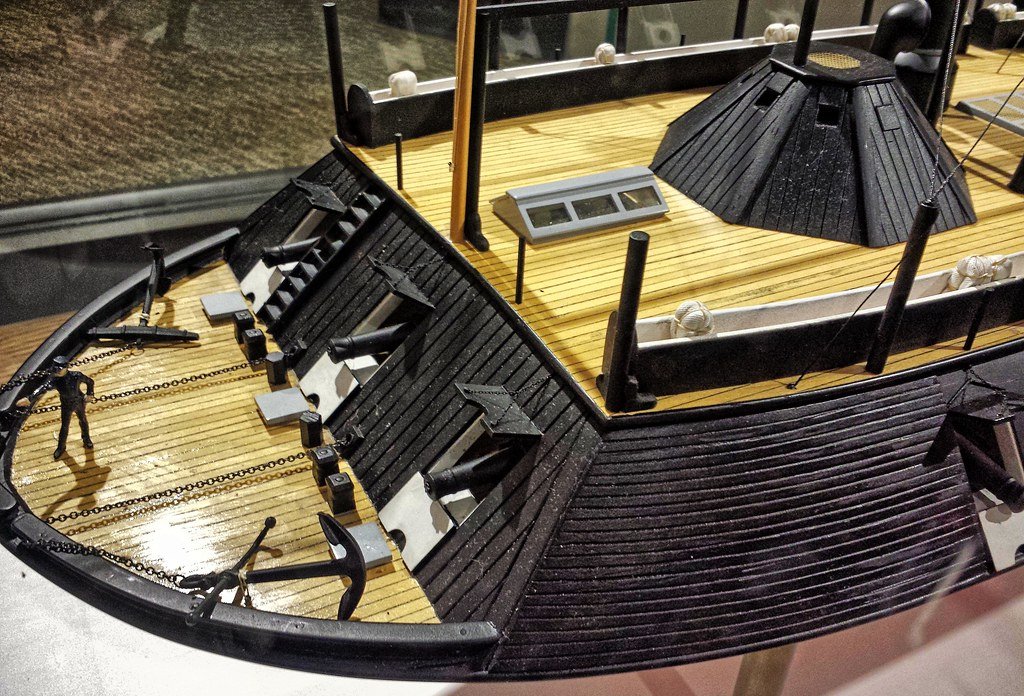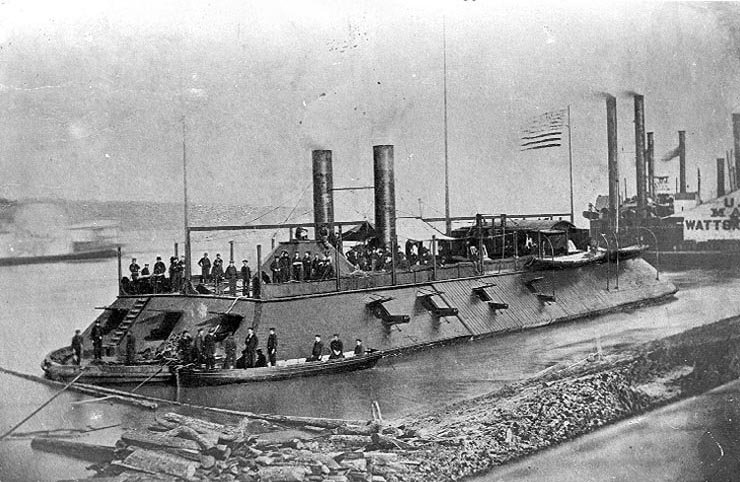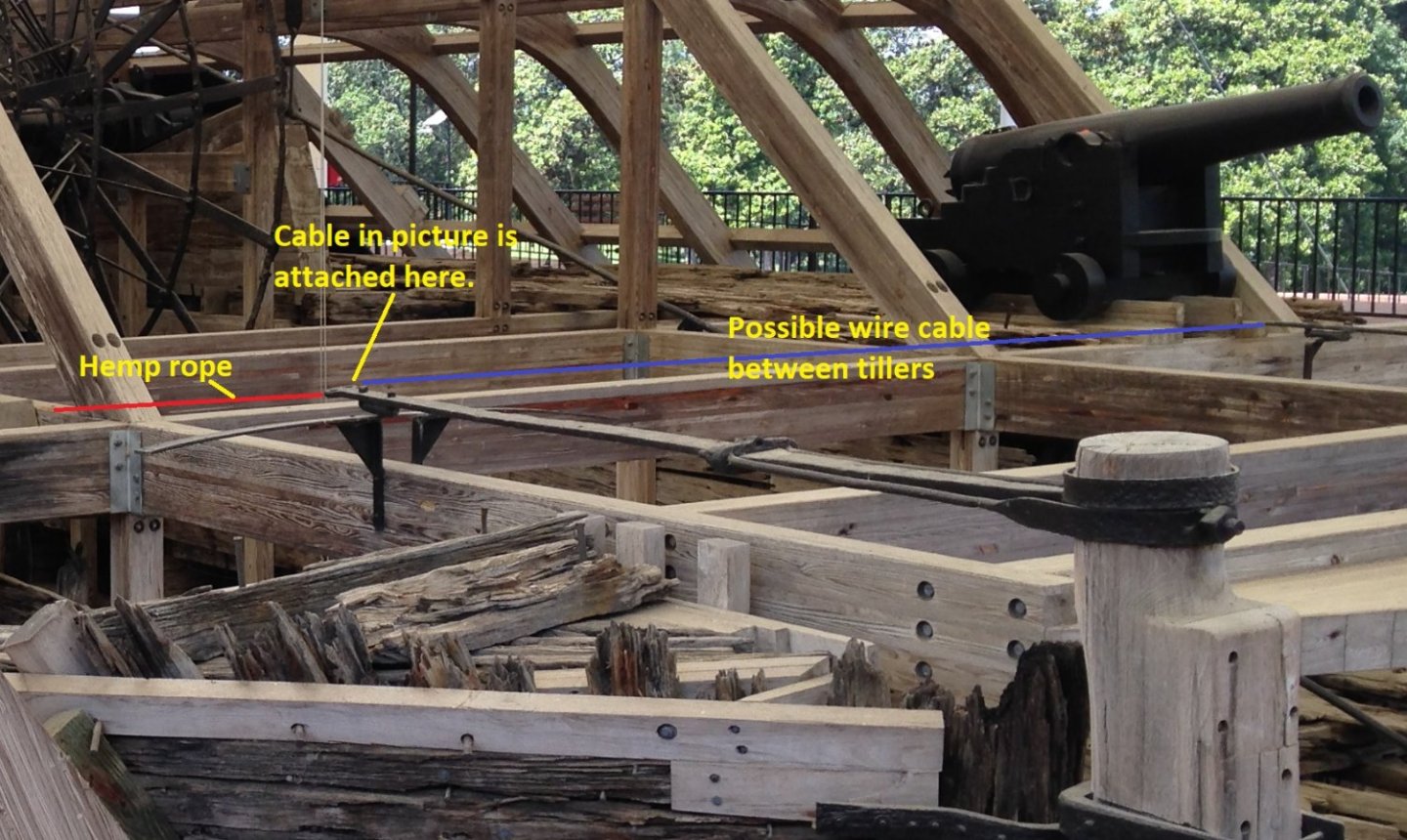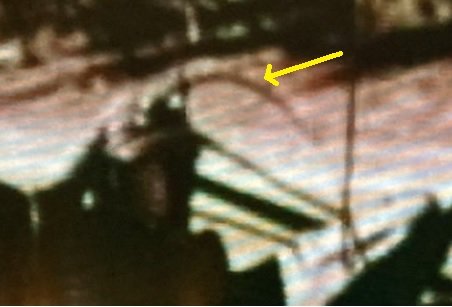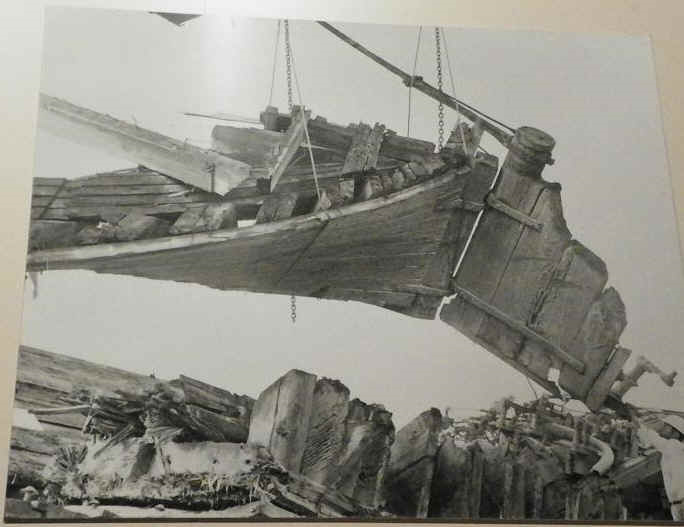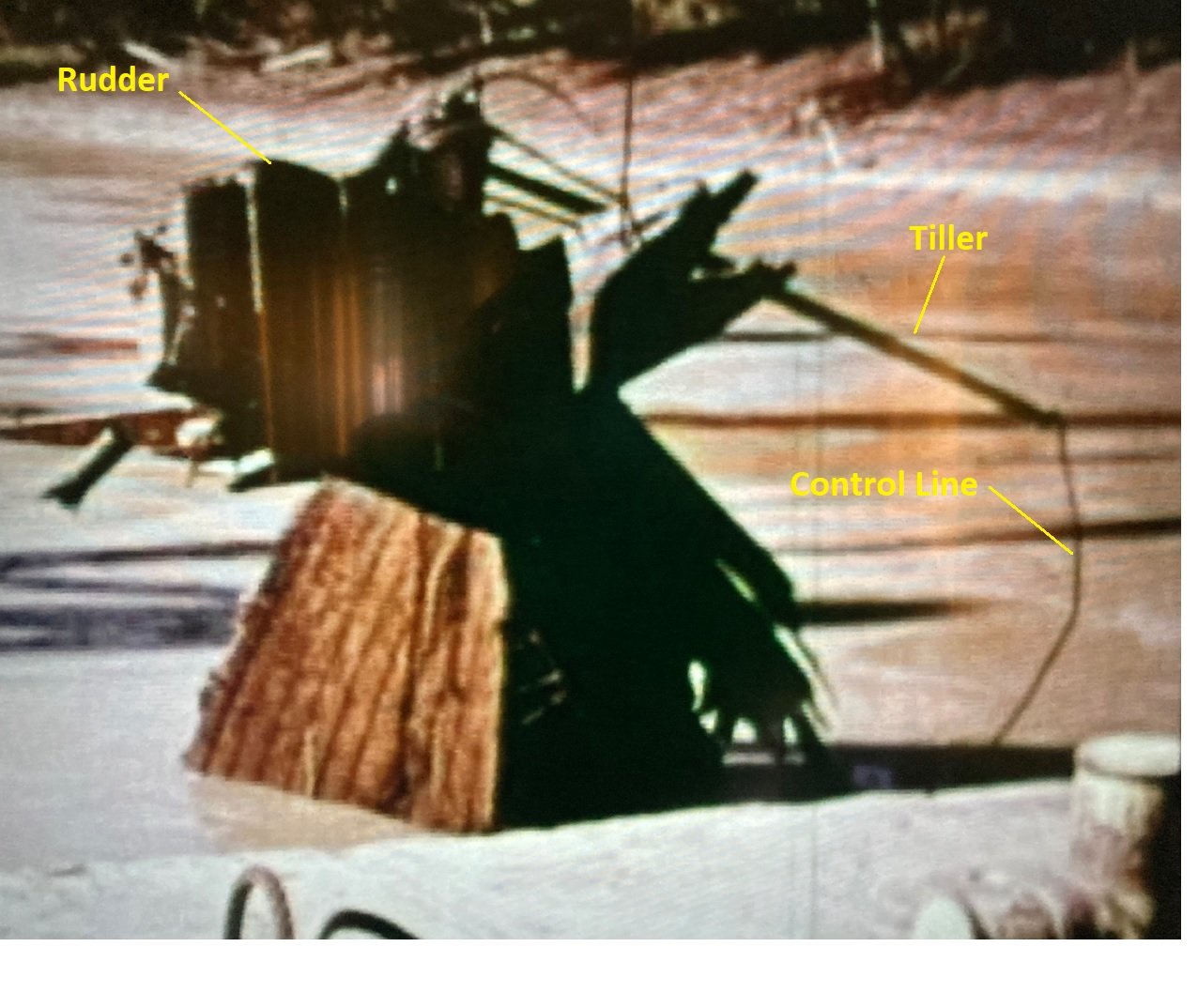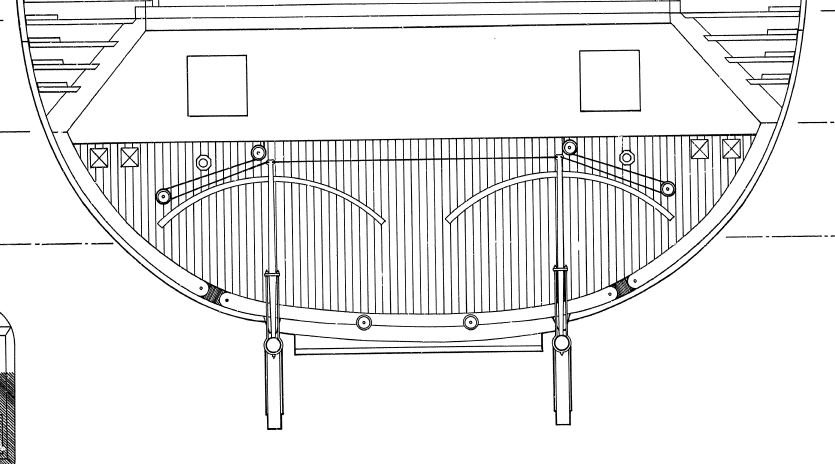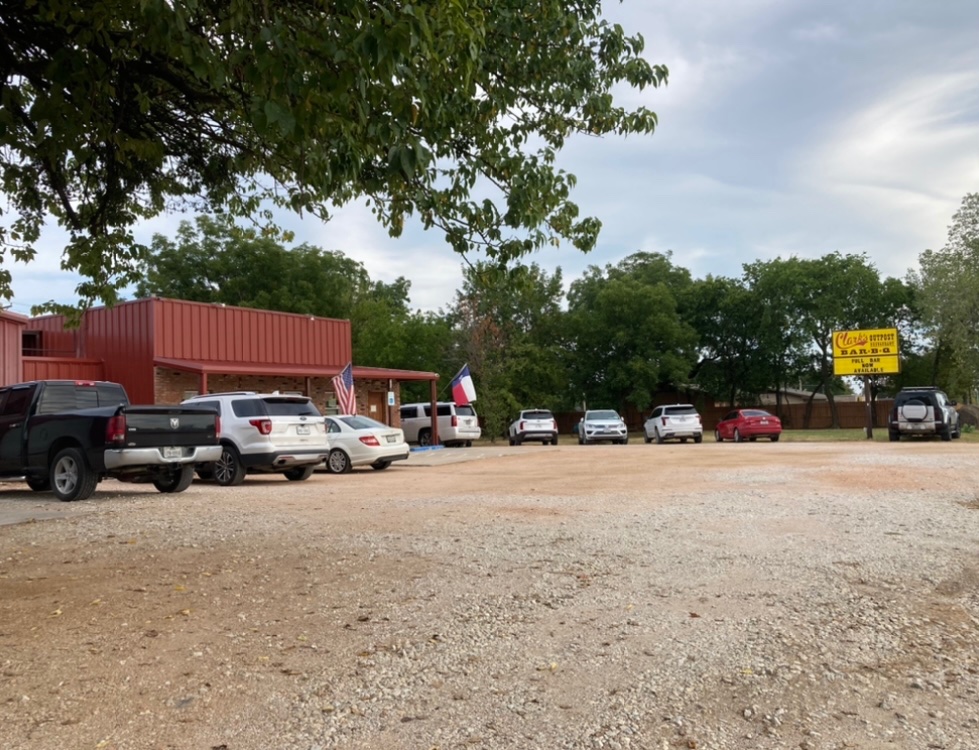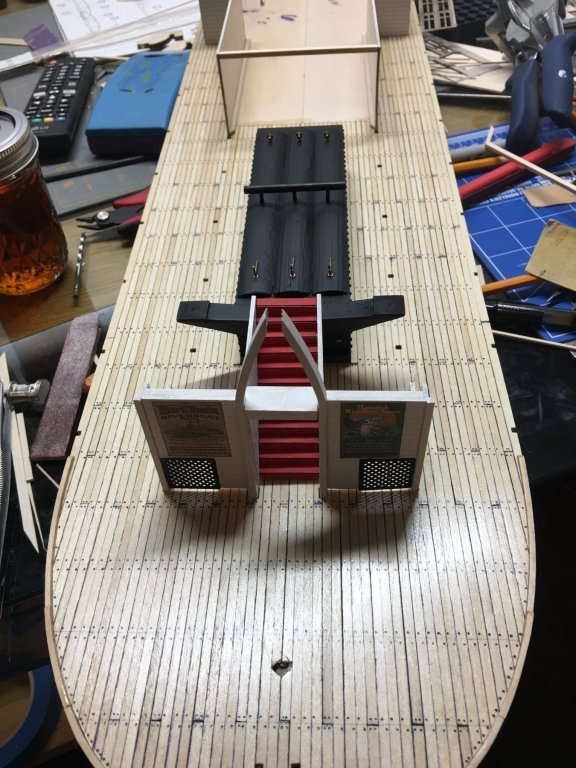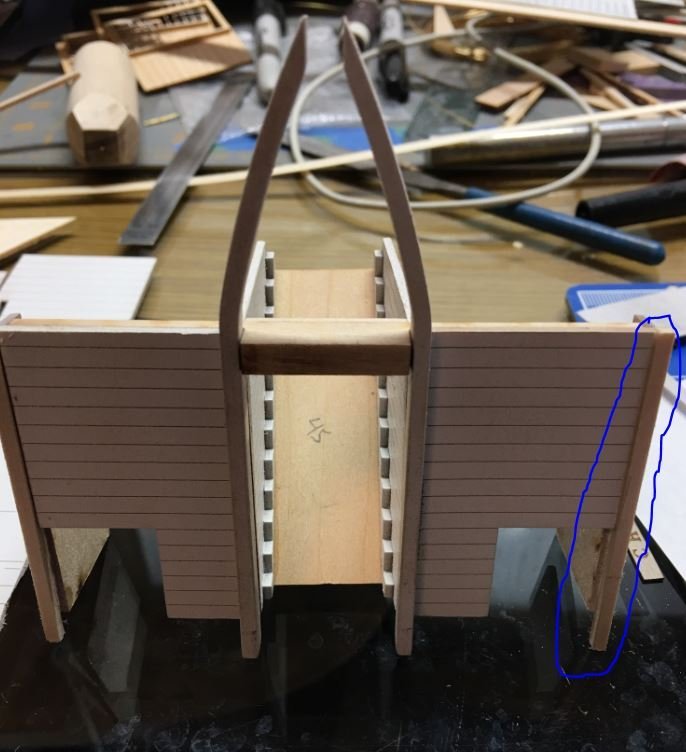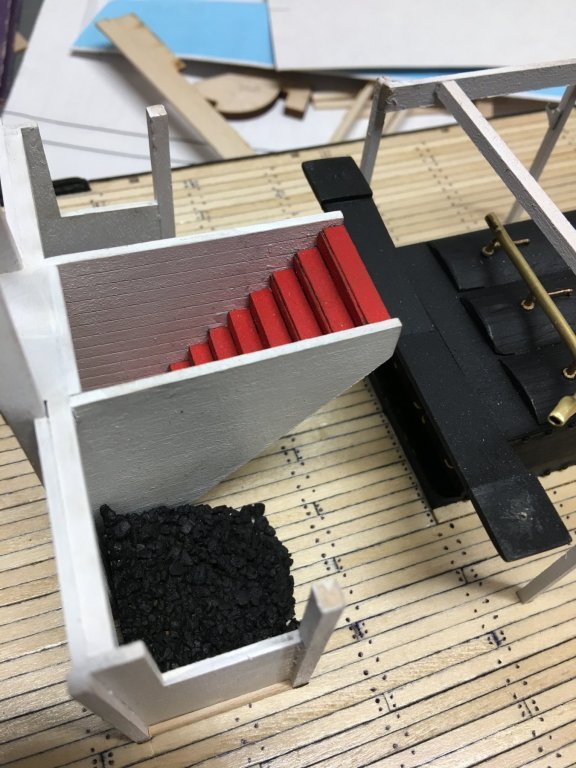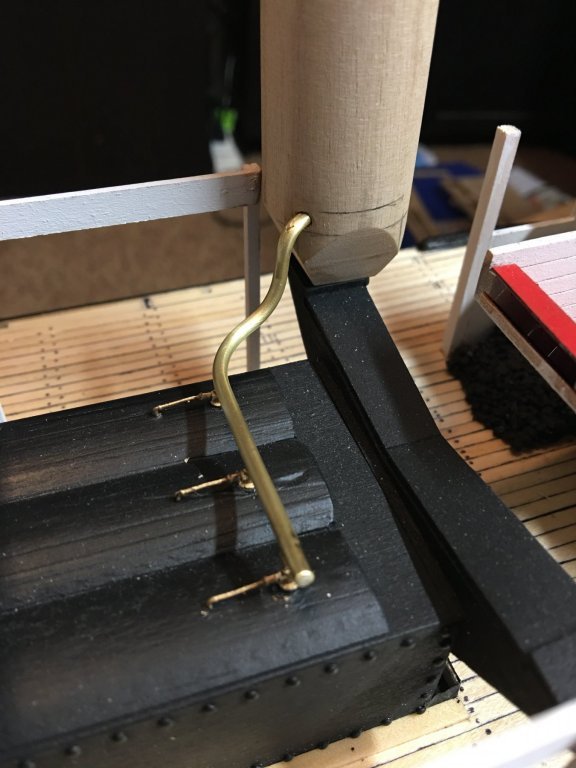-
Posts
996 -
Joined
-
Last visited
Content Type
Profiles
Forums
Gallery
Events
Everything posted by mbp521
-
Interesting article George. There was a lot of litigation and controversy surrounding the bridge in the beginning. Seems like there still is a bit of controversy as well, with people not knowing how to read road signs. Especially the instances where several busses have tried crossing it with clearly marked signage and height barriers. I haven't looked into it, but I wonder if the bridges construction led to the steamboats having to redesign their smokestacks with hinges to clear the bridge. -Brian
-
I see what you are referring to now. I actually didn't notice that until now, thank you for pointing that out. I didn't use this model as a reference too much for my research, since there are several inaccuracies with it, but It would make sense to have the doors in that configuration with the smaller guns back there. There were several "executive decisions" that I made throughout this build due to lack of information. Many of the decisions I based on the photographs or additional documented information of the sister ships, especially the Cincinnati and Mound City since they were all built in the same shipyard in Mound City. These boats were designed for frontal assaults, this was the reason for all the big guns to be located in the forward position and the reinforced forward casement. I read somewhere (I forget the reference, it might have been in the "Hardluck Ironclad") where someone had stated that Cdr. Selfridge had the Cairo's guns arranged in an unusual configuration. I do not recall the reasoning behind it, but strategically it made sense, and she was setup quite differently than her sisters were. -Brian
-
Leiste, I'm not real sure of which model you are referring to, The Cairo museum only has two models on display, one which is a representation of the current display outdoors showing the cradle and the existing original fabric. This model, like the actual boat does not have the forward gun port doors on it. The other model is complete boat with the side cutaway, and it does have the forward gun port doors pierced on the upper and lower sections. In the contemporary photo of the Cairo, you can see that the forward gun port door were pierced on the tops and bottoms. Only the Port and Starboard #3 & #4 gun port doors were pierced on the lower section only. This was the location of four of the smaller 32lb guns. As for the aft gun ports, it is hard to tell if they were pierced on the top and bottom or just the bottom, since there are no photographs of this are on the original boat, bit they were also smaller guns (32 pounder and 30lb Parrot) and could have been pierced on the bottom only. I just went with the photos of her sister ships that have the aft gun port doors pierced top and bottom. -Brian
-
Lieste, Thank you for the specification on the munitions. I totally agree that the Parrot would have most likely not used round shot. At the time I made up the ammo crates I wasn't thinking that much of this would have been seen and didn't put too much focus into the interior details in this area. As the build progressed, I started focusing more on the details but eventually this area got covered up and it was too late to go back and change. Unfortunately this area still cannot be seen. This past May I had the opportunity to see first hand the actual ammunition that Cairo carried and you are correct, they did indeed use ogive shot in the 30lb Parrot. These are some of the 30lb Parrot rounds recovered from the wreck. -Brian
-
Johnny, Thank you for the very useful info. I've got a feeling that this will most likely be the route that I take on the construction of the intermediate link. Still researching, but it seems to be the most reasonable solution. Roger, I totally agree with the turnbuckle. I would think that over time the hemp rope would stretch causing the rudders to get out of alignment, or bending of the tillers for that matter, making adjustments necessary. Turnbuckles on the intermediate link and internally on the control lines would help with the adjustments. Mark, I was thinking the same thing. Wire rope could also cause some wear and tear on the hawse pipe as well. Similar to what I mentioned previously with the chain theory. Thank you all for the valuable input. -Brian
-
Thank you Roger for the additional input. It truly helps give me some direction. An executive decision is most likely what I will be doing here, it definitely wouldn’t be the first time. I’m still doing a little digging to see if I can turn something up that can confirm my suspicions. At the moment I am seriously leaning towards the solid rod for the intermediate link and hemp rope for the control lines, I just want to make sure that I do my due diligence first. I wasn’t aware that Eades had built a suspension bridge in WVA, most of the research I’ve done on him focused on his bridge in St. Louis, I guess since it is the one still standing. The man definitely had his hands in a lot of projects. You definitely bring up a good point on the hog “chain” theory. I hadn’t even thought about that. I’ll also need to keep that in mind while researching to make sure that I am clear on the specifics of the reference. As for her being a riverboat, Cairo’s (and her sisters) hull design was not new, they were based on Sam Pook’s existing hulls for some of his earlier boats, and that is what I am researching right now to see if any of these boats have a similar steering system. So far I haven’t found much, but I’m still looking. -Brian
-
You are correct, the area on the fantail was exposed, as were all control lines from the hawse pipe to the tillers. They were susceptible the elements and enemy fire. After reading the comments above, I got to thinking even more about this. I am not so sure that what I thought was wire cable in my initial post, could have not actually been an iron connecting bar that got bent during the salvage. An iron connecting bar makes better sense given the pressure of the water and the push pull action on both rudders. Like you said earlier, even severing one side of the control line would disable the steering functionality regardless of the makeup of the intermediate link between the tillers. This also got me to wondering about the control lines to the ships wheel. If the exposed area was actually chain, how much wear and tear on the hawse pipe would that cause? Seems to me that the constant steering adjustments made when the ship was under way would cause significant rubbing and wear in this area creating frequent maintenance problems. It would also seem that if it were chain, it would have still been attached when they pulled that section up from the river. In the salvage video, there is no sign of chain or linkage where this would have been attached on the tiller. This leads me to believe that the outboard control lines were hemp rope that had rotted away. -Brian
-
Amazing work as always Keith. Do you have a current shot of what she looks like now, or did I overlook one in a previous post? -Brian
-
Eric, I am assuming you are talking about this semi-circular feature here. If so, that is the tail of the lifting cable that is looped through the shackle. I had to go back and re-watch the video to be sure. In that picture it does look a bit odd since it somewhat blends in with the shore in the background. The tiller is actually still attached to the top of the rudder. Here is another photo that shows it from a different angle when they were offloading the piece from the barge at Ingalls Shipyard. Unfortunately, the cable cannot be seen in this photo and could have been removed during transport or just not shown, and the chains in this picture are part of the lifting sling. Mark, indeed this is a deep rabbit hole. Now you and Eric have really got me to thinking even more. I am now wondering if the control lines from the wheel to the outboard sides of the tiller was made from hemp rope and the connecting line between them was wire cable. This would explain the absence of the rope on the outboard side of the tillers, as it could have rotted away and the presence of the cable on the inboard side of the tillers would indicate that they were made from two different materials. That is a great question, but unfortunately this is the only City Class gunboat in existence, and of the remaining Ironclads (3) none of them had any of the stern section recovered and none had a similar style of steering system. I am going to have to see if I can dredge up some info on other Ironclads that had this type of steering system and see what was used on them. And the search continues. -Brian
-
Greetings everyone, I have hit a snag on my build and wanted to throw this out there to see if I could get an opinion from the experts to help me out. I am fast approaching the installation of my rudders and have been doing a considerable amount of research on how they were controlled. On the City-Class gunboats, the pilot house was mounted on the hurricane deck housing the ships wheel. The control ropes for the rudder tillers ran through the gun deck, most likely along the roof beams toward the aft casement, where they dropped down to deck level and through the casement just above the deck. They were then rigged through another series of pullies on the fantail where they were attached to each of the rudder tillers on the outboard sides. There was also a connection between each of the tillers on the inboard sides of each one to keep them aligned. I have read several stories of where sharpshooters would target these exposed control lines for the rudders in an effort to disable to boats and make them easier targets. I have also read, and had several discussions that conflict on what the makeup of the control lines were. They have been referred to as rudder ropes, rudder chains, rudder cables and rudder lines in several documents which makes it difficult to determine what they used. I have also read references that they may have had some sort of hybrid makeup where the control lines from the ships wheel to the aft casement were made of rope. They were then tied to chains which ran through the casement, around the pullies and attached to the tiller. But through my research, the majority of the accounts say that the exposed control lines were chain. Some of my thoughts on this were that if the control lines were made from rope the entire length, they could have easily been severed by a well-placed shot. If the control lines were made up of chain, it seems like it would have been a little harder to take out the control lines with a mini-ball. Not saying it would be impossible, just a little tougher. The chain option could have also been a retrofit after several rope lines were severed. Seems that retrofitting happened a lot with these boats. This brings me to the theory that the control lines could have been made up of wire rope, or steel cable. Wire rope had its beginnings in the early 1830’s Europe and was primarily used for elevators and cranes, but not widely used for much more. I have also been having trouble trying to find any information on when steel cable was incorporated into marine usage, but I am pretty sure it could have been during the mid 19th century. However, I managed to get my hands on the salvage video of the Cairo and stumbled across an interesting shot that helps prove my cable theory. In the below snapshot from the video (apologies for the graininess, it’s hard to take a picture of a TV screen and have it come out clear), it shows the Port rudder being pulled from the Yazoo River, and if you look closely, you can see what appears to be a wire rope (steel cable) attached to the tiller on the right side of the shot. The reason that I believe this is a wire rope is due to the kink in the middle, between the tiller and the waters surface. Seems to me that chain would hang straight down as would regular rope. It would also seem that you would be able to see the links in the chain or at least it wouldn’t have as smooth of features if the chain was caked with mud blocking the links. Anyway, I was hoping to get some opinions on my theory that the rudders were controlled on the Cairo by wire rope and not chain or regular rope, before proceeding with my rudder installation. As always, thank you for stopping by. -Brian
-
The bikers are usually there on the weekends. It supposed to be nice here Saturday so I’m sure they will be there. -Brian
-
Stéphane, mon français est un peu rouillé, ça fait plus de 40 ans que je l'ai pris à l'école. Cependant, avec l'aide de Google Translate, je peux peut-être réussir. Merci beaucoup pour les gentils commentaires. Je suis heureux que certains de mes conseils aient été utiles et je suis toujours heureux de les partager. I hope I got that right. -Brian
-
Glad to help out. If you follow the below link there are several contemporary photos of the Chaperon in her hey day. The link is to the University of Wisconsin - Madison La Crosse and they have an excellent collection of old photographs of not just the Chaperon, but numerous other steamboats, Some of these photos also show many of the changes Chaperon had through her career and a couple of them from back when she was the JC Kerr. If I am not mistaken, in some of the photos you can see the changes the area in question above went through over time. If anything, the old pictures are neat to look at. https://search.library.wisc.edu/search/digital?q=chaperon&filter[facets][collections_facet~Historic+Steamboat+Photographs]=yes -Brian
- 157 replies
-
- chaperon
- Model Shipways
-
(and 1 more)
Tagged with:
-
John, Eric has described it correctly and should be installed per the drawing and his instructions in the above post #42 from your log. There is a gotcha in there though, before you glue the corner strips in, align the pieces 37P/S up with the holes in the deck to make sure they go in properly. You can reference entry #11 on page 1 of my build log to see how I assembled everything and the trouble I had getting it all together. The picture that Eric provided is after the installation, entry #45 and entry #41 is the installation These are on page 2 of my build. I also posted the pictures below, but the build describes the process a little better. Also, when you get to this point, here is the way that I built the vent pipe for the safety valves. I formed it up before installing the hurricane deck since it was a lot easier to access. Once the deck was installed I came back and installed the pipe. It was still a little tricky, but it was a whole lot easier without the deck in place. Hope this helps. -Brian
- 157 replies
-
- chaperon
- Model Shipways
-
(and 1 more)
Tagged with:
-
All of these small towns are starting to grow. Everyone wants to get out of the Metro-mess. Love Clark’s Outpost. Eat there pretty regularly. They actually burned down about five years ago. Took them a couple of years to get back up and running in their new building, but they are still just as good. -Brian
-
Nice progress John. One of the great things about this kit is that it leaves plenty of options for upgrading the features on it. I also agree, Model Expo’s customer service is top notch. Every time I have gone to them with a broken, missing or misplaced part, they have been Johnny on the spot with a replacement. Keep up the great work! -Brian
- 157 replies
-
- chaperon
- Model Shipways
-
(and 1 more)
Tagged with:
-
Looks like Vicksburg is a good meet between place. It’s right at 300 miles from me as well. I love the nostalgia of the town, and you are correct, the battlefield and the Cairo are the main attractions. When I was there back in May, I had a lengthy conversation with the Cairo supervisor, he had mentioned that the Cairo exhibit is the main draw to the park and that if had been located closer to the park entrance, there would be hardly any traffic through the rest of the park. And I highly recommend Tony’s Seafood for lunch or dinner the next time you make it there. As for Norfolk, that would be quite the haul from Texas, but I might touch base with Ryland to see what it takes to get a model on exhibit in a maritime museum. That’s too funny Keith. It would take all of two days for the entire towns population of 800 people to see it and get bored with it. 😁 However, the 25 mile trip from my house would be better than the 300 miler to Vicksburg. -Brian
-
Thank you Don for the kind words. As of right now I don't have any plans to show it and to be honest I haven't really checked to see if there are any shows locally. I'm kind of stuck between two major metropolitan areas that I think would host any kind of model show, DFW & OKC, which are both 80-120 miles away. If I could find one a little closer, I might consider entering it. My dream would be for it to be shown in the Cairo museum. But that will probably remain just that, a dream. Keith, now there is a good idea. I could place a binder next to the boat display with some of the interior pictures in it. I am proud of the way my boiler and engines came out, but so far my favorite piece has to be the paddlewheel. This was one of the hardest parts of the build, covering that piece up. When I get to building the display case, I am going to mount the boat up on pedestals high enough to place a mirror under the hull so you can see the paddlewheel. I even put lights in the wheel house to make sure it could be seen. -Brian
-
Mr. Bean, Keith, Pat, Steven, thank you all for the great comments. They truly mean a lot. Keith, like you said, there are a lot of hidden details, and it's almost a shame that I covered them up. Thank goodness I have this build log to go back and look at some of them. When I started this build, I didn't really have a clear picture as to what I was going to do other than build the boat from the plans that I found on the NPS website. As I went along, the more conversations I had with fellow shipbuilders and the more research I did on the subject, helped provide me with the inspiration to do more. It seems like every time I look at the old photos of the City-Class boats, or read something else about them, I find an interesting new detail about them that I want to add. The only problem with this, that I can see, is when do I stop? I want to make the model as historically accurate as possible so I'll need to draw the line somewhere but it is just so much fun adding each piece to the build. Guess I'll cross that bridge when I get there, but until then I'll just keep on keeping on. -Brian
-
Hello again everyone, I'm back with another update. This is truly a brief one. Lot's of pictures, but not a lot of work over the past month. We have been caught in the midst of a major drought here, no rain locally for over 50 days, and coupled with triple degree temps for over 30+ days has made our area a veritable tinder box outside, I am on our towns volunteer fire department and we have been up to our ears with grass fires. So, needless to say, between the grass fires and work life, not a lot of time has been spent in the shipyard. So, picking up where I left off last time. I managed to finish up work on the mess kits. I found a simple solution to making the padlocks for them. I had a bunch of #8 lead bird shot that I used for cannon balls on a previous build. I took these and flattened them out and used a nail punch to form the shackle. I drilled out a hole in the shackle and looped it through a small eyebolt and I think the results look pretty convincing. Once these were all completed, I staged them up for placement on the deck. All glued together. Glued into place on the deck. Next up, I finally gave up on trying to find information on how the ships bell was mounted and went with my intuition. I know that salvage divers place the bell in front of the wheelhouse structure, but there is no documentation on what it was mounted on. It was too big to just hang on the wall, so I went with the flag locker theory. Simple construction of the locker. I used some leftover grating for the dividers and made up a small box to form the locker. I then painted the locker up, printed out a set of signal flags to stuff in the cubbies and mounted the bell to the top of the locker. All flags in place Flag locker in place. After the flag locker was completed, I wanted to add some more details to the deck, so I made up a stack of crates that are covered by a tarp. I built up a bunch of scrap blocks and added some trim to them to give the tarp some shape and detail. Next, I used the same method of soaking a tissue with some 50/50 water and clear Elmer's glue that I used on the hammocks. Once it was all dry, it was time to add some weathering. Here we have a nice dingy tarp. This looks like a good location to store these crates. More deck details. I installed a couple of the forward mooring ropes. First, I soaked the ropes in a 50/50 water/glue solution to help hold the ropes shape. Soaked ropes were then installed on the deck and laid out and left to dry. I used some Press-n-Seal to keep the glue from getting all over the deck. Starboard side was then installed. The Press-n-Seal was then removed and the ropes were then glued into place. Finally, a little weathering was added to the ropes to give them that '"muddy, used" look. The contemporary photo of the Cairo has what looks to be a longer mooring rope attached to one of the bitts and thrown up over the forward casemate where it would have been stored along the hammock nets. My guess is that there wasn't much room on the foredeck to store a lot of rope, so they made use of the space on the hurricane deck and stored the longer, bulkier rope there. I am going to add this feature as well, just because. I also, finally trimmed up the anchor chains and attached the anchors to them. Still haven't decided exactly how I am going to display these. I may have one in place on the deck and the other just hanging overboard. I'll figure it out eventually. Next was the installation of the center, forward and aft masts. Aft mast being secured to the stanchion. Center mast. I didn't have any black scale rope on hand, so I used tan and dyed it black. Center mast complete. Now the challenge is to see if I can finish up working around these masts without breaking them off. Next up was the smokestack for the cookstove. Just some brass tubing for the pipe, the hood was made from copper sheeting and brass strips for the hood supports. Smokestack installed. Finally. I finished up the port side hammock and tarps and added some more deck details. I built up the hammock net walls that would have been installed between the last set of stanchions, but were removed to provide easier access to the ships boats. On one of the contemporary photos of the St Louis (Baron DeKalb) you can see these walls stored on top of the aft roof of the wheelhouse structure, so that is where I placed mine. I also threw on some additional crates and tarps scattered about and weathered them up. I think I need a few more details on the deck, so I'll give it some more thought and see what else I can come up with. Lastly, as she sits right now. Please pardon the messy workbench, I forgot to tidy things up before taking the as-is picture. Well that is all for this update, I hope to have more next time around. Thank you so much for stopping by. As always, I do appreciate all of the nice comments and likes. -Brian
-
Thank you Gary for the kind words and the pointers. I to am no expert on photography. I stick to the simpler things when it comes to picture taking. If my iPhone had more than two buttons required to take a picture, I would be lost. I look at my daughters digital SLR and I might as well be trying to solve the answers to the universe and world peace. I'm sure it's pretty easy to use once you use it a few times, just never really had the ambition to learn it, and I never thought that model shipbuilding would lead to photography. Kinda missed that one. I do like the idea of the snakeskin slippers. 😁 However, he was a bit small. I'll need a few more of his cousins to make a good pair. He might have made a nice hat band though. -Brian
-
This is most likely the reason for them pulling kids chemistry sets off the shelves, too many young ones blowing up their parents garages. I for one know that I killed off more than a few brain cells back in the day experimenting with the different chemicals provided in my set. -Brian
About us
Modelshipworld - Advancing Ship Modeling through Research
SSL Secured
Your security is important for us so this Website is SSL-Secured
NRG Mailing Address
Nautical Research Guild
237 South Lincoln Street
Westmont IL, 60559-1917
Model Ship World ® and the MSW logo are Registered Trademarks, and belong to the Nautical Research Guild (United States Patent and Trademark Office: No. 6,929,264 & No. 6,929,274, registered Dec. 20, 2022)
Helpful Links
About the NRG
If you enjoy building ship models that are historically accurate as well as beautiful, then The Nautical Research Guild (NRG) is just right for you.
The Guild is a non-profit educational organization whose mission is to “Advance Ship Modeling Through Research”. We provide support to our members in their efforts to raise the quality of their model ships.
The Nautical Research Guild has published our world-renowned quarterly magazine, The Nautical Research Journal, since 1955. The pages of the Journal are full of articles by accomplished ship modelers who show you how they create those exquisite details on their models, and by maritime historians who show you the correct details to build. The Journal is available in both print and digital editions. Go to the NRG web site (www.thenrg.org) to download a complimentary digital copy of the Journal. The NRG also publishes plan sets, books and compilations of back issues of the Journal and the former Ships in Scale and Model Ship Builder magazines.



